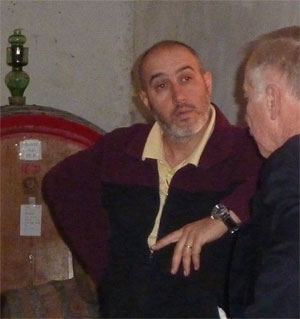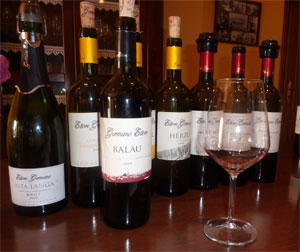Germano Ettore: Innovation and Tradition in Barolo Country
© by Neil Duarte
I have written before about Serralunga d'Alba, a small village in the Langhe Valley of Piedmont, some 60 miles southeast of Turin, Italy. Here you find the second largest production of Barolo wine as well as a number of other excellent wines made from local and imported grape varieties. Wineries vary in size from the largest, Fontana Freda, where 6 million bottles/year are produced to very small wineries where less than 20,000 bottles/year are made. Most of the wineries produce in the range of 100,000- 150,000 bottles/year and offer several varieties of red and white wines using nebbiolo, Dolcetto, Barbera and various imported white grapes including Chardonnay.
One such smaller winery is the Germano Ettore estate (www.germanoettore.com), located just north of the town of Serralunga d'Alba on a hill named "Cerretta". With a south southwest face, the estate is comprised of 13.5 hectares (approximately 35 acres) and grows Nebbiolo, Barbera, Dolcetto, Chardonnay and Riesling grapes all destined for estate vinification. Though the Germano family has been farming and making wine for the past 158 years in the area, the current location was started as a 3 hectare plot (approximately 7.5 acres) by Ettore Germano and his father Alberto who sold most of their grapes to other winemakers. The addition of Ettore's son, Sergio, in 1990 expanded the small amount of wine produced and since 1993 all grapes produced are made into estate wines. Today Sergio and his wife Elena, plus a small staff oversee all aspects of cultivation and winemaking.
 | |
| Sergio Germano explains his winemaking procedures Photo: Terry Duarte. |
Germano Ettore makes three white wines. We began with the DOC Langhe Chardonnay, a 100 percent Chardonnay which is harvested in mid-September and after several rackings is allowed to mature in stainless steel tanks. Like most Langhe Chardonnays, this one is made in the style of Burgundy Chardonnay wines. It was slightly yellow in appearance, slightly fruity and very smooth to the taste. It was a very nice wine.
Next we tried another DOC, the Binel Langhe Bianco. Harvested slightly later in the end of September or early October, this wine is a blend of 60 percent Chardonnay and 40 percent Riesling. The Chardonnay is fermented in barriques while the Riesling is fermented in stainless steel tanks. This blend was also light yellow in appearance, slightly more fruity and had a smooth, light finish, making it a good selection as a cocktail wine.
We finished the whites with a third DOC, Herzu Langhe Bianco. This 13 percent alcohol pure Riesling was the biggest surprise so far. It was the lightest of the whites in appearance, had a very pleasant fruity nose and really finished smoothly. This was one of the best Rieslings I had ever tasted. When I asked Sergio why he made a pure Riesling, he offered his signature philosophy of "because I wanted to make it". I call this innovation in his product line and after tasting it, I am glad he did.
Impressed by the white wine offerings of Germano Ettore, we then moved to the reds. The estate produces a wide range of red wines, all using Langhe local grapes. We began with Dolcetto d'Alba Lorinzino (Dolcetto means "little sweet one", but these are all dry wines), a 100 percent Dolcetto harvested in mid-September. Deep purple in color and slightly fruity, Dolcetto is normally drunk when young (less than 4-5 years old). The Lorenzino was deep in color, fruit forward and very smooth in taste. As a note, most of the house red wine served in the Langhe Valley is Dolcetto from the area around the eating place. Next we tried another DOC Dolcetto d'Alba, Pra Di Po. Harvested slightly after the Lorenzino, this 100 percent Dolcetto has its fermentation and maturation accomplished in stainless steel tanks. The Pra Di Po was stronger in taste than the Lorenzino, colored as deeply and slightly less fruity. Both were very good wines but I prefer a lighter Dolcetto and hence the Lorenzino. It would be interesting to taste the Pra Di Po in a few years as I have the feeling that it will age well.
 | |
| The tasting lineup at Germano Ettore Photo: Terry Duarte. |
We returned to the local grapes with the DOC Langhe Nebbiolo, one of my favorite reasonably priced wines of the area. Like most Nebbolio wines this one was high in tanins, not fruitly in aroma but complex and had a strong and very pleasing finish. One bottle of this would never be enough.
Now we moved to the moment of greatest anticipation, the tasting of the Barolos. The estate produces three different Barolos. We began with the DOCG Barolo Serralunga. Made from grapes from 10-year-old vines (and older) in a soil of medium marly-calcareous mixture, the wine represents the estate's youngest vines, located in Prapo and Cerretta. As expected, it was very good indeed, but the age of the vines made it less intense than other Barolos.
The next wine offered was the DOCG Barolo Cerretta, the largest Barolo production from the estate at 12,000 bottles/year. Produced from 30-year-old vines in limestone and clay soil and allowed to mature in new or slightly used French barrels for 24 months, Cerretta had an excellent, intense nose with the classic Nebbolio long and smooth finish. We finished with the DOCG Barolo Lazzarito Riserva, produced from 75-year-old vines in marly-calcareous soil. It is fermented through 30 days maceration on the skins followed by 30 months aging in 2000-liter oak casks and finally held in its bottles for 24 additional months. If you ever want to try a magnificent Barolo, this should be on your list. My notes here have one word: fabulous. As good as the other Ettore Germano wines had been, this was clearly the best. My compliments go to Sergio Germano.
As I complete this article, I reflect back to that day at the Germano Ettore winery, and all I can think of is the pure pleasure of meeting Sergio and his family and having the good fortune of tasting his excellent wines. If you look on their web site you will note that they offer a few rooms as an Agriturismo. I can think of few places in which I would rather awaken than on the Germano Ettore estate. Their US distributors are shown on their web site. Enjoy!
January 2010
